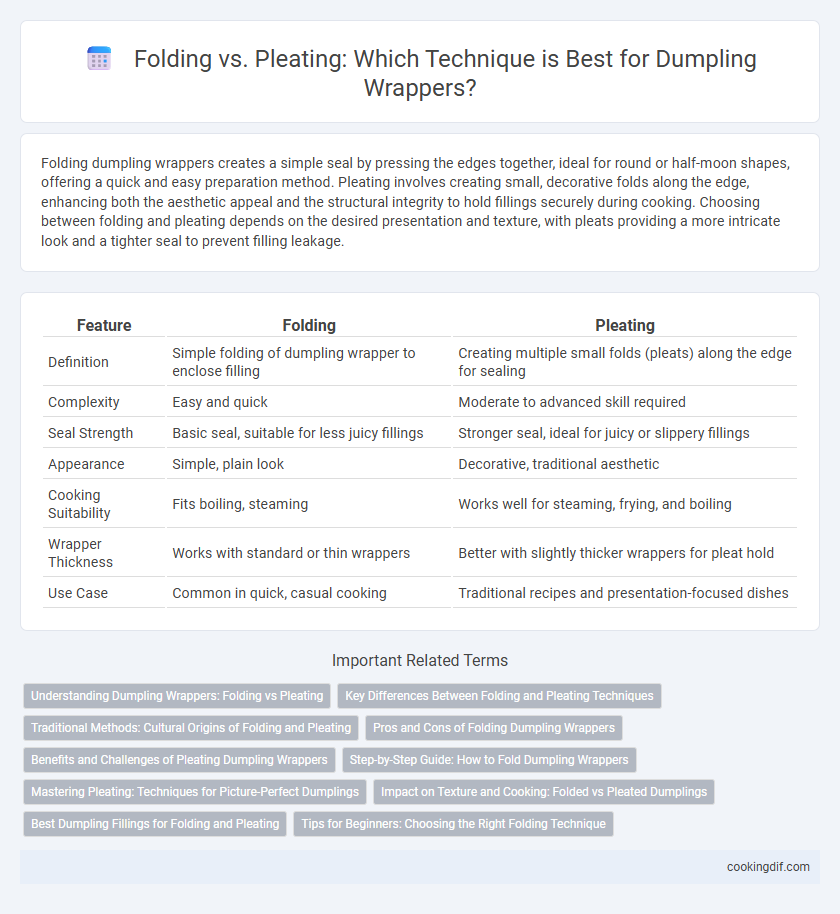Folding dumpling wrappers creates a simple seal by pressing the edges together, ideal for round or half-moon shapes, offering a quick and easy preparation method. Pleating involves creating small, decorative folds along the edge, enhancing both the aesthetic appeal and the structural integrity to hold fillings securely during cooking. Choosing between folding and pleating depends on the desired presentation and texture, with pleats providing a more intricate look and a tighter seal to prevent filling leakage.
Table of Comparison
| Feature | Folding | Pleating |
|---|---|---|
| Definition | Simple folding of dumpling wrapper to enclose filling | Creating multiple small folds (pleats) along the edge for sealing |
| Complexity | Easy and quick | Moderate to advanced skill required |
| Seal Strength | Basic seal, suitable for less juicy fillings | Stronger seal, ideal for juicy or slippery fillings |
| Appearance | Simple, plain look | Decorative, traditional aesthetic |
| Cooking Suitability | Fits boiling, steaming | Works well for steaming, frying, and boiling |
| Wrapper Thickness | Works with standard or thin wrappers | Better with slightly thicker wrappers for pleat hold |
| Use Case | Common in quick, casual cooking | Traditional recipes and presentation-focused dishes |
Understanding Dumpling Wrappers: Folding vs Pleating
Folding and pleating techniques for dumpling wrappers create distinct textures and structural integrity, crucial for different dumpling styles like potstickers or wontons. Folding typically involves simple, clean edges that hold fillings securely, while pleating forms intricate ridges that enhance the wrapper's grip and visual appeal. Mastery of these methods affects cooking outcomes, influencing moisture retention and bite experience.
Key Differences Between Folding and Pleating Techniques
Folding and pleating dumpling wrappers are distinct techniques that impact texture and appearance; folding creates simple, clean edges with a smooth finish, while pleating involves pinching small, decorative folds along the wrapper's edge to form intricate patterns. Pleated dumplings typically feature a more traditional aesthetic and enhanced structural integrity, preventing filling from leaking during cooking. The choice between folding and pleating depends on desired visual appeal, ease of preparation, and the type of dumpling being made.
Traditional Methods: Cultural Origins of Folding and Pleating
Traditional folding and pleating methods for dumpling wrappers reflect rich cultural origins, with folding often linked to Chinese cuisine emphasizing simplicity and function, while pleating is prominent in Japanese and Korean dumplings, showcasing intricate craftsmanship. Folding creates clean, sealed edges essential for boiling or steaming, whereas pleating adds texture and aesthetic appeal favored in pan-fried or steamed dumplings. These techniques not only preserve culinary heritage but also influence the dumpling's texture, cooking style, and regional identity.
Pros and Cons of Folding Dumpling Wrappers
Folding dumpling wrappers offers a quick and simple method, making it ideal for beginners and speeding up the cooking process. This technique creates a sturdy seal that helps retain the filling's moisture but may result in less decorative edges compared to pleating. However, folding can sometimes cause uneven thickness, potentially affecting the dumpling's texture and overall cooking consistency.
Benefits and Challenges of Pleating Dumpling Wrappers
Pleating dumpling wrappers enhances the dumpling's structural integrity, ensuring a tight seal that prevents filling from leaking during cooking. This technique creates an aesthetically pleasing, textured edge that improves grip when eating and frying, contributing to a better overall experience. However, pleating requires skill and precision, making it more time-consuming and challenging for beginners compared to simple folding methods.
Step-by-Step Guide: How to Fold Dumpling Wrappers
Folding dumpling wrappers involves creating simple, smooth edges by pressing two sides together, while pleating requires making small, precise folds along the edge to form decorative ridges. Start by placing a small amount of filling in the center of the wrapper, then fold it in half and gently press the edges to seal, ensuring no air pockets remain. For pleating, use your thumb and index finger to make uniform folds along one side of the wrapper while pressing it against the opposite side, achieving a firm, attractive seal.
Mastering Pleating: Techniques for Picture-Perfect Dumplings
Mastering pleating for dumpling wrappers involves precise, evenly spaced folds that create a decorative, textured edge enhancing both appearance and texture. Techniques include consistent pinching and pressing along the wrapper's edge to form tight pleats, ensuring the filling is securely enclosed and the dumpling maintains shape during cooking. Perfect pleating not only elevates presentation but also improves structural integrity, preventing leaks and promoting even cooking results.
Impact on Texture and Cooking: Folded vs Pleated Dumplings
Folding dumpling wrappers creates a denser, chewier texture that holds fillings securely, resulting in a firm bite after steaming or boiling. Pleating introduces multiple thin layers and air pockets, producing a lighter, flakier texture with enhanced crispness when pan-fried. The choice between folding and pleating directly influences moisture retention and cooking time, affecting the dumpling's final texture and mouthfeel.
Best Dumpling Fillings for Folding and Pleating
Folding dumpling wrappers works best with moist, finely chopped fillings like pork and cabbage or shrimp and chive to ensure a secure seal and balanced texture. Pleating suits heartier fillings such as ground beef with garlic or mixed vegetables that benefit from the additional structural support and decorative edge. Choosing the right filling enhances the dumpling's integrity and flavor, making folding ideal for delicate mixtures and pleating perfect for robust, chunky ingredients.
Tips for Beginners: Choosing the Right Folding Technique
Selecting the right folding technique for dumpling wrappers greatly influences the final texture and appearance of your dish. Beginners should start with simple folds like the half-moon to ensure even sealing and consistent cooking, while pleating offers a decorative edge that helps trap fillings securely, ideal for more experienced cooks. Using a small amount of water to moisten the wrapper edges prevents unintentional openings during steaming or frying, enhancing the dumpling's structural integrity.
Folding vs Pleating for dumpling wrappers Infographic

 cookingdif.com
cookingdif.com